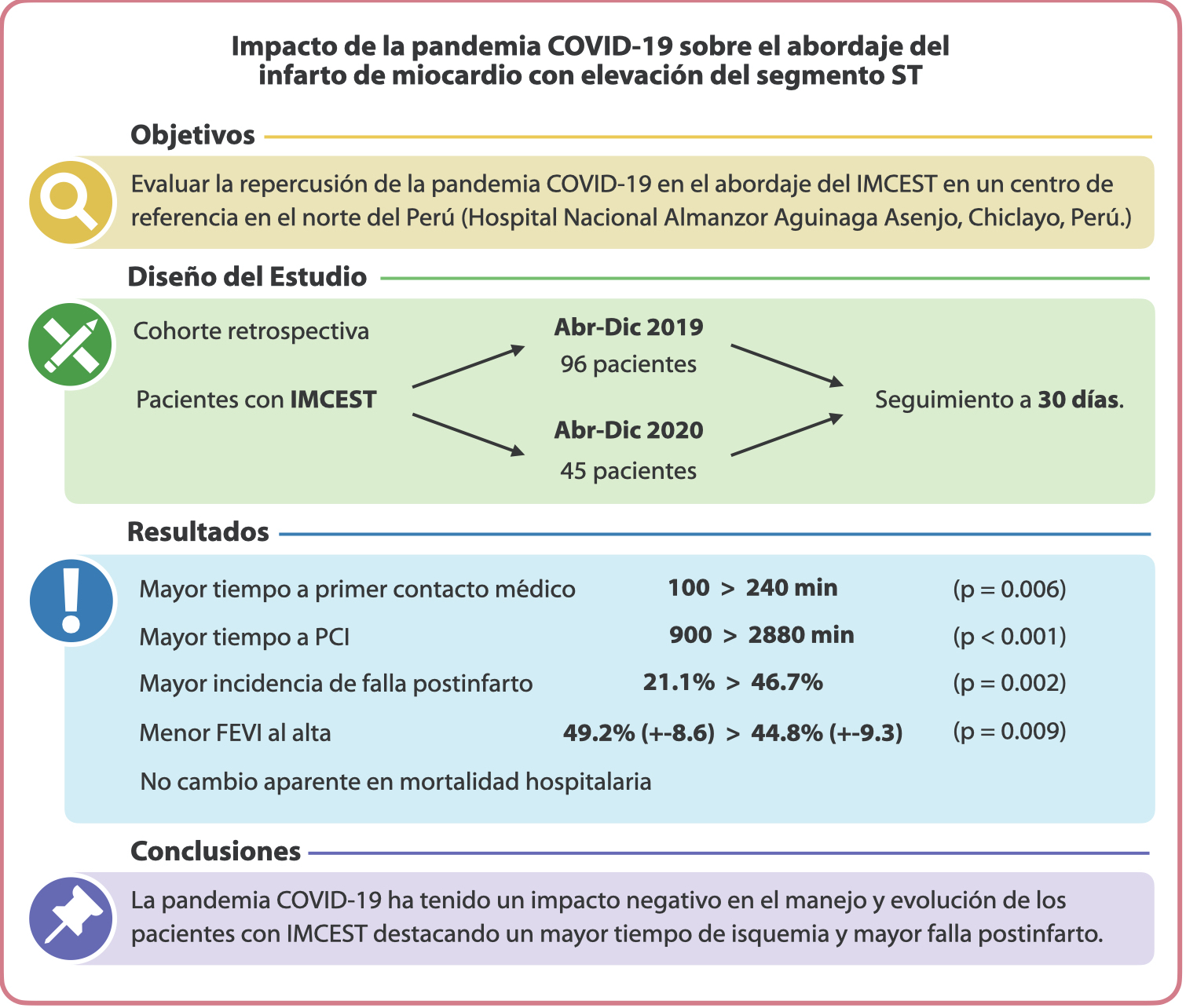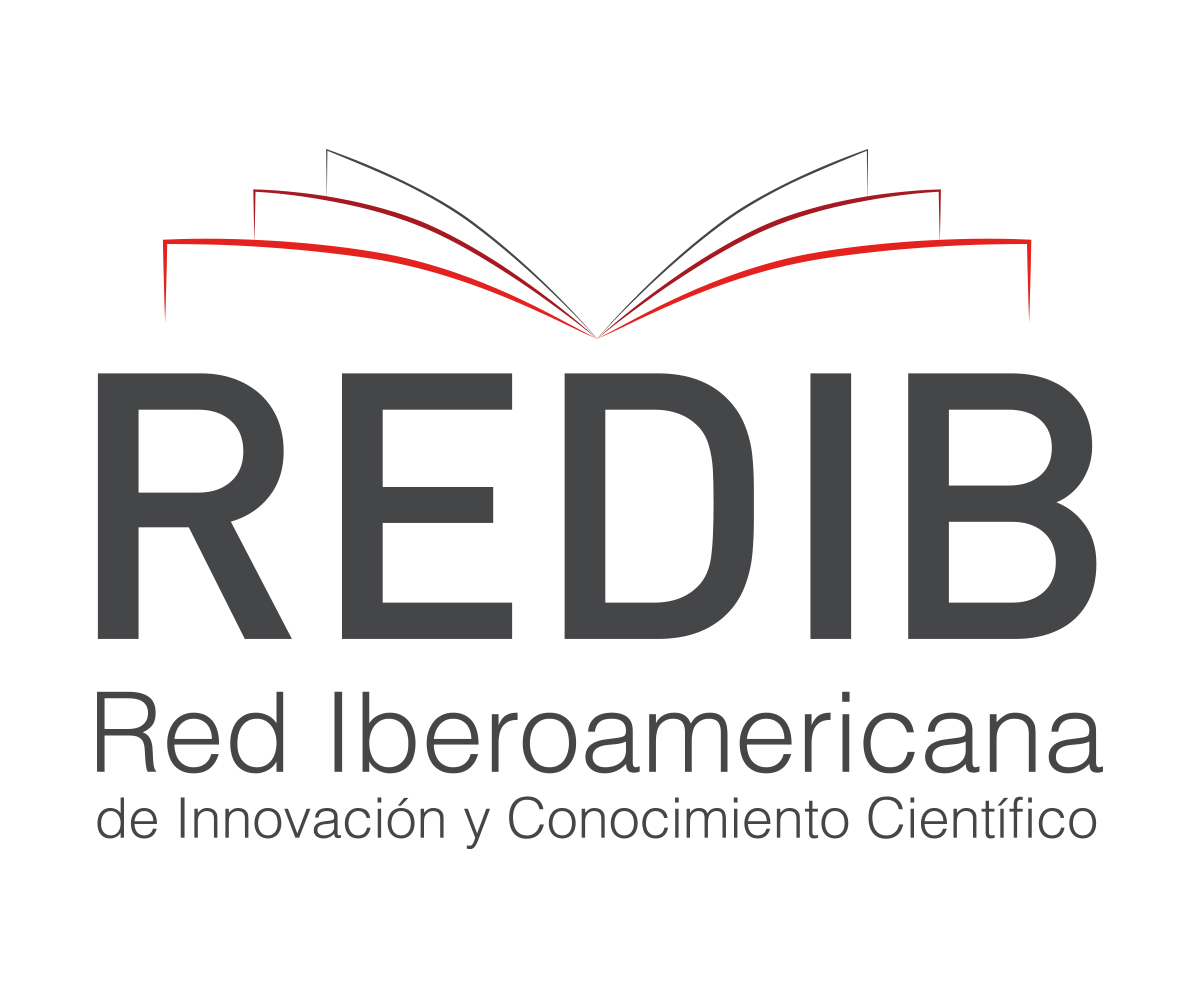Impact of the COVID-19 pandemic on ST – elevation myocardial infarction management in a reference center of northern Peru
DOI:
https://doi.org/10.47487/apcyccv.v2i3.148Keywords:
Myocardial infarction, COVID-19, Myocardial reperfusionAbstract
Objective. To evaluate the impact of the COVID-19 pandemic on the ST–Elevation myocardial infarction (STEMI) management in a reference center of northern Peru. Methods. Observational, analytical, retrospective cohort-type study, derivated from the Acute Coronary Syndrome registry of the Almanzor Aguinaga Asenjo National Hospital. The characteristics of the patients with STEMI and their 30-day outcomes were compared in 02 cohorts according to the time of medical care: prior to the pandemic or during the pandemic. Results. During the COVID-19 pandemic, hospitalizations for STEMI decreased by 53%, there was a greater use of fibrinolysis to the detriment of primary angioplasty, with increases in the time of first medical contact (100 vs. 240 minutes, p = 0.006) and ischemic time to percutaneous coronary intervention (900 vs. 2880 minutes, p <0.001). This generated a higher frequency of post-infarction heart failure (21.1% vs. 46.7%, p = 0.002) and a lower left ventricular ejection fraction at discharge (49.2 +/- 8.6 vs 44.8 +/- 9.3, p = 0.009), without an increase in in-hospital cardiovascular mortality. Conclusions. The COVID-19 has had a negative impact on the treatment of patients with STEMI. We found less hospitalizations, prolonged reperfusion times, and higher frequency of post-infarction heart failure and lower left ventricular ejection fraction at discharge.
Downloads
References
Tomasoni D, Adamo M, Italia L et al. Impact of COVID-2019 outbreak on prevalence, clinical presentation and outcomes of ST-elevation myocardial infarction. J Cardiovasc Med (Hagerstown). 2020 Nov; 21(11):874-881. doi: 10.2459/JCM.0000000000001098.
Rodríguez-Leor O, Cid-Álvarez B, Pérez de Prado A, et al. Impacto de la COVID-19 en el tratamiento del infarto agudo de miocardio con elevación del segmento ST. La experiencia española [Impact of COVID-19 on ST-segment elevation myocardial infarction care. The Spanish experience]. Rev Esp Cardiol. 2020 Dec;73(12):994-1002. Spanish. doi: 10.1016/j.recesp.2020.07.033.
Custodio - Sánchez, P., Miranda, D., & Murillo, L. (2020). Impacto de la pandemia por COVID-19 sobre la atención del infarto de miocardio ST elevado en el Perú. Archivos Peruanos De Cardiología Y Cirugía Cardiovascular, 1(2), 87 - 94. https://doi.org/10.47487/apcyccv.v1i2.22
De Rosa S, Spaccarotella C, Basso C et al. Reduction of hospitalizations for myocardial infarction in Italy in the COVID-19 era. Eur Heart J. 2020 Jun 7;41(22):2083-2088. doi: 10.1093/eurheartj/ehaa409.
Giulio G. Stefanini, Matteo Montorfano et al. ST-Elevation Myocardial Infarction in Patients With COVID-19. Circulation. 2020; 141:2113–2116. DOI: 10.1161/CIRCULATIONAHA.120.047525
Choudry FA, Hamshere SM, Rathod KS et al. High thrombus burden in patients with COVID19 presenting with ST-segment elevation myocardial infarction. J Am Coll Cardiol 2020; 76:1168–76. doi: 10.1016/j.jacc.2020.07.022.
Ibáñez B, James S, Agewall S et.al. Guía ESC 2017 sobre el tratamiento del infarto agudo de miocardio en pacientes con elevación del segmento ST. Rev Esp Cardiol 2017; 70(12): 1082.e1- e61. DOI: 10.1016/j.recesp.2017.10.048
Chacón-Diaz M, Vega A, Aráoz O et al. Características epidemiológicas del infarto de miocardio con elevación del segmento ST en Perú: resultados del PEruvian Registry of ST-segment Elevation Myocardial Infarction (PERSTEMI). Arch Cardiol Mex. 2018; 88(5):403 - 412. DOI: 10.1016/j.acmx.2017.11.009
Perrin N, Iglesias JF, Rey F, et al. Impact of the COVID-19 pandemic on acute coronary syndromes. Swiss Med Wkly. 2020 Dec 31;150:w20448. doi: 10.4414/smw.2020.20448.
Gorini F, Chatzianagnostou K, Mazzone A, et al. "Acute Myocardial Infarction in the Time of COVID-19": A Review of Biological, Environmental, and Psychosocial Contributors. Int J Environ Res Public Health. 2020 Oct 9;17(20):7371. doi: 10.3390/ijerph17207371.
Woolf S.H., Chapman D.A., Sabo R.T., et al. Excess Deaths From COVID-19 and Other Causes, March-April 2020. JAMA. 2020;324:510–513. doi: 10.1001/jama.2020.11787.
Sánchez Fernández L, Álvarez Rodriguez J, Casado Flores I, Botas Rodríguez J, de Albas Montero J, de Andrés, et al. Codigo Infarto Madrid. Madrid. 2013. Disponible en: http://www.somamfyc.com/Portals/0/PropertyAgent/400/Files/416/C%C3%B3digo%20Infarto%20DEF.pdf
Betriu A, Masotti M. Comparison of mortality rates in acute myocardial infarction treated by percutaneous coronary intervention versus fibrinolysis. Am J Cardiol. 2005 Jan 1;95(1):100-1. doi: 10.1016/j.amjcard.2004.08.069.
Gozzer E, Canchihuamán F, Espinoza R. COVID-19 y la necesidad de actuar para mejorar las capacidades del Perú frente a las pandemias. Rev Peru Med Exp Salud Publica. 2020;37(2):371-3. doi: https://doi.org/10.17843/rpmesp.2020.372.5410.
Ortigosa Aso J et al. Estrategias de reperfusión en el infarto agudo. Rev Esp Cardiol. 2008;61(1):6-9. DOI: 10.1157/13114950
Zeng J, Huang J, Pan L. How to balance acute myocardial infarction and COVID-19: the protocols from Sichuan Provincial People’s Hospital. Intensive Care Med. 2020 Jun;46(6):1111-1113. doi: 10.1007/s00134-020-05993-9
Ehtisham Mahmud, Harold L. Dauerman, Frederick G.P. Welt, et al. Management of Acute Myocardial Infarction During the COVID-19 Pandemic. J Am Coll Cardiol 2020; 76: 1375 – 84. DOI: 10.1002/ccd.28946
Keeley EC, Boura JA, Grines CL. Primary angioplasty versus intravenous thrombolytic therapy for acute myocardial infarction: a quantitative review of 23 randomised trials. Lancet. 2003;361:13-20. DOI: 10.1016/S0140-6736(03)12113-7
Huynh T, Perron S, O’Loughlin J, et al. Comparison of primary percutaneous coronary intervention and fibrinolytic therapy in ST-segment-elevation myocardial infarction. Bayesian hierarchical meta-analyses of randomized controlled trials and observational studies. Circulation. 2009;119:3101-9. DOI: 10.1161/CIRCULATIONAHA.108.793745
De Luca G, Verdoia M, Cercek M, et al. Impact of COVID-19 Pandemic on Mechanical Reperfusion for Patients With STEMI. J Am Coll Cardiol. 2020 Nov 17;76(20):2321-2330. doi: 10.1016/j.jacc.2020.09.546.
Kwok CS, Gale CP, Mamas M, et al. Impact of COVID-19 on percutaneous coronary intervention for ST-elevation myocardial infarction. Heart. 2020 Dec;106(23):1805-1811. doi: 10.1136/heartjnl-2020-317650.
Uwe Primessnig, Burkert M. Pieske, Mohammad Sherif. Increased mortality and worse cardiac outcome of acute myocardial infarction during the early COVID‐19 pandemic. ESC Heart Failure 2021; 8: 333–343. https://doi.org/10.1002/ehf2.13075
Jordan RE, Adab P, Cheng KK. Covid-19: risk factors for severe disease and death. BMJ. 2020 Mar 26;368:m1198. doi: 10.1136/bmj.m1198.
Ortiz-Prado E, Simbaña-Rivera K, Gómez-Barreno L, et al. Clinical, molecular, and epidemiological characterization of the SARS-CoV-2 virus and the Coronavirus Disease 2019 (COVID-19), a comprehensive literature review. Diagn Microbiol Infect Dis. 2020 Sep;98(1):115094. doi: 10.1016/j.diagmicrobio.2020.115094.















